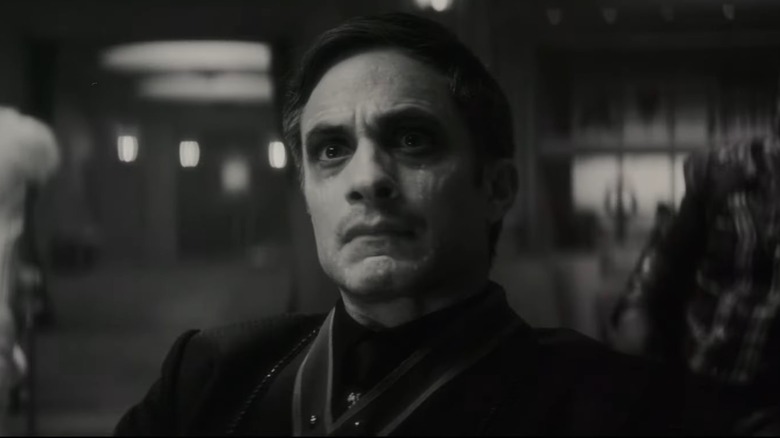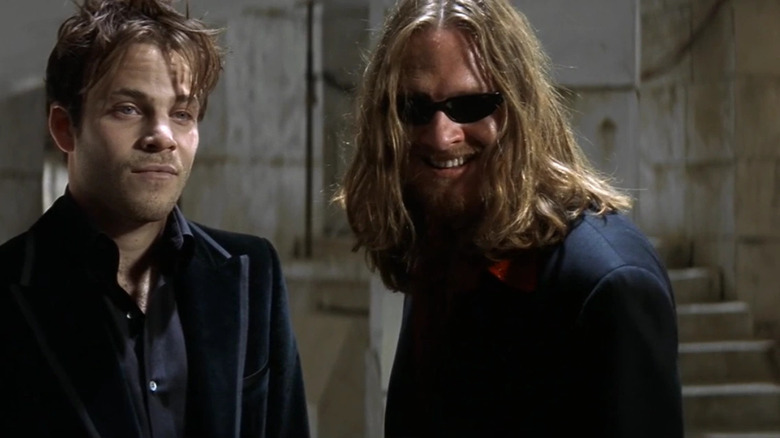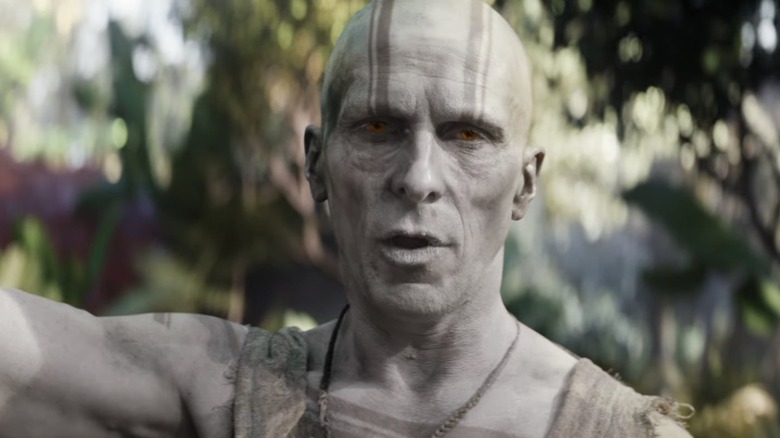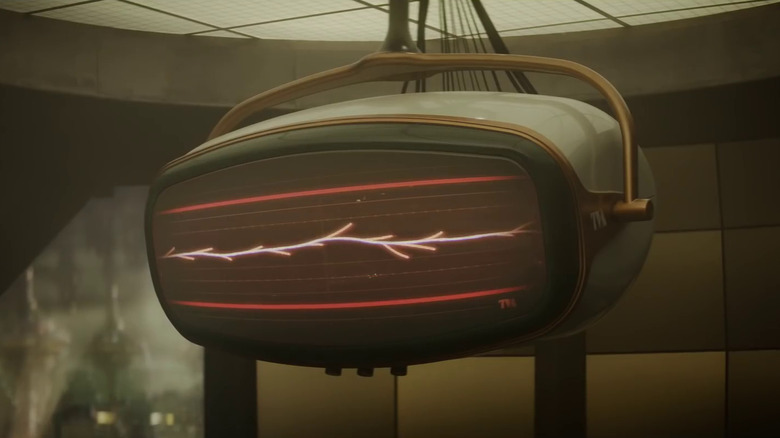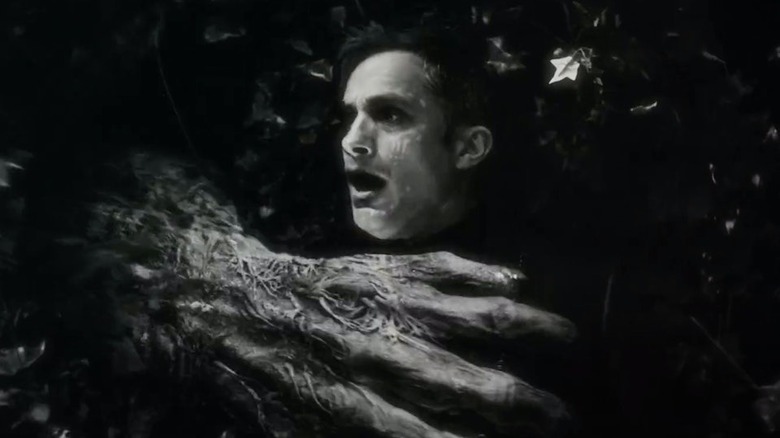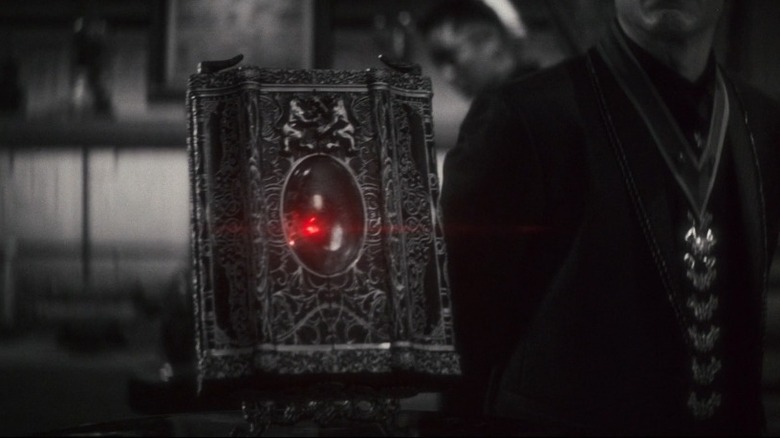The Best Easter Eggs And Small Details In Marvel's Werewolf By Night
Shows and movies set in the Marvel Cinematic Universe are rich with Easter eggs. They have been since 2008's "Iron Man," when a prototype of Captain America's shield appeared in a scene between Tony Stark and Pepper Potts. What's refreshing about "Werewolf by Night," then, is how Easter eggs are some of its only connections to the larger MCU.
Michael Giacchino's "Twilight Zone"-indebted special for Disney+ is a genuinely different outing for Kevin Feige's monolithic brand. It's shot in black and white. Most of its effects appear to be practical. The violence is genuinely brutal and bloody, and the story's connections to Marvel's ever-expanding shared universe are minimal at best (at least for now). For those who want to scour "Werewolf by Night" for hidden characters and references, however, there's still a trove of tiny details to unpack. Here are the best easter eggs in "Werewolf by Night," some of which you might have missed.
A series of illustrations, part one: monstrum alatum
In its first moments, "Werewolf by Night" delivers some Easter eggs for fans to sift through. The special presentation opens with a black-and-white etching of the Avengers team circa 2012, when the lineup consisted of Hawkeye, Black Widow, Captain America, Iron Man, Hulk, and Thor. It pans down to reveal another sketch of a monstrous creature with long, gleaming teeth and pitch-black eyes. Writing to the side of this image reads "monstrum alatum," a Latin phrase that translates to "a winged monster."
Though the word "vampire" doesn't appear here, the creature's appearance and description appear to confirm two things. One is that vampires exist in the MCU. Second, they've been around since at least Phase One of the MCU. As narration that accompanies this camera pan postulates, "The known universe, with its heroes and marvels, but what of the darkness? In our modern world, this is where monsters dwell, along with those who hunt and slaughter them with pride."
We get hints at what (or who) more of these monsters are as "Werewolf by Night" progresses, but this is a revelatory start, particularly given the impending arrival (although not too impending, as it turns out) of "Blade." The illustrations that follow have even more to offer.
A series of illustrations, part two: something Gorr-y
Shortly after this Gothic prologue, we see Jack (Gael Garcia Bernal) arrive at Bloodstone Manor. A creaking lift opens, revealing the wary hero and a hallway full of illustrations that he must walk down. These pictures further reinforce the special's connections to the MCU, including one that's particularly important to Phase Four at large.
An image on the walls is almost a direct recreation of a pivotal moment from Jason Aaron's "Thor" run, which introduced Gorr the God Butcher, villain of "Thor: Love and Thunder." There are a couple of differences, but they're minor. In the comics, Gorr is seen getting, well, gored by a large ax. Here, he is attacked ruthlessly by soldiers with spears. Still, the reference is clear. More confusing is Gorr's appearance in the "Werewolf by Night" illustration, which is closer to his comic book design than Christian Bale's look in "Love and Thunder."
What isn't hard to infer, though, is this: If everything that appears in Bloodstone Manor is about those who hunt and those who are hunted, it looks like the Bloodstone family slaughtered Gorr's kin at some point, bare minimum. That is reason enough to fear them, and to believe in the legitimacy of both the Bloodstone and the family's legacy of carnage.
The Bloodstone Manor trophies, part one: Bigfoot
One major difference between the comic book movie fandom of yore and its present-day iteration is how little work those who love it have to do these days. Case in point: Within a day of "Werewolf by Night" dropping on Disney+, director Michael Giacchino broke down the creatures that appear throughout the special for IGN. No more going through Marvel movies and shows frame-by-frame with fellow fans. The info now comes straight from the source.
So, let's begin with the most fun Easter egg in "Werewolf By Night," one that's present thanks to Giacchino's childhood nightmares. Bigfoot exists in the MCU, and he's dead. The infamous sasquatch can be seen when Jack (Gael Garcia Bernal) first arrives at Bloodstone Manor. More specifically, Bigfoot's head can be spotted hanging high atop one of the cavernous entrance walls.
According to Giacchino, the mythic creature is only in the special because the director-composer was "terrified of [him] as a kid ... so when they were asking me 'what monsters do you want up there' I said 'I want Bigfoot ... because he terrorized me my entire childhood.'" Giacchino goes on to describe how the TV special "In Search of Bigfoot" gave him nightmares, and it seems reasonable to infer that he hopes "Werewolf by Night" will do the same to younger viewers. The special is an hour of precisely calibrated gateway horror, and Bigfoot's head is one of the giveaways.
The Bloodstone Manor trophies, part two: Krogg and a vampire
Bigfoot's head isn't the only visible trophy in Bloodstone Manor, however. A more recognizable Marvel character can be found there, too. Krogg is a classic "Werewolf by Night" villain. The demon made his first appearance in 1973's "Werewolf by Night" #8, and his backstory is wild even by comic book standards. Summoned to Earth by a malevolent pharmacist? Check. Imprisoned in a cavern because the pharmacist couldn't control him? Check again.
Less is said about him, though, than a winged creature who bears a perfect resemblance to the monstrum alatum from the "Werewolf by Night" title sequence. When Jack spies this creature, he jokes, "I've fought him many times, and he's never looked so alive." This moment is further confirmation that vampires exist in the MCU. It also reveals that they've been a nagging presence for years, and aren't content to hide in the shadows.
In 1998's "Blade," Deacon Frost grumbled, "Maybe it's time we forgot about discretion. We should be ruling the humans, not running around making back-alley treaties with them ... These people are our food, not our allies." Again, with the MCU's "Blade" movie on the horizon and vampires' hanging heads on Bloodstone Manor's walls, the end of discretion may be fast approaching.
Ted
Man-Thing is too important to "Werewolf By Night" to be a genuine Easter egg. There is, however, a comedic reveal that makes Man-Thing's direction in the MCU much clearer. When Jack (Gael Garcia Bernal) advises Elsa Bloodstone (Laura Donnelly) on how to soothe the mystical swamp creature during an attempt to free him, he says to call him "Ted."
As long-time comic readers know, "Ted" refers to Ted Sallis, the Empire State University biochemistry professor who develops the SO-2 Serum and, eventually, injects it in himself. The SO-2 Serum is an attempt to update the supersoldier serum that transformed Steve Rodgers into Captain America, and Empire State University is the school attended by Peter Parker which employs Curt Connors, also known as the Lizard. Clearly, Ted's MCU connections are myriad. Ted takes the serum when fleeing armed forces and crashes his car into a swamp that isn't what it seems. He then becomes the Man-Thing. You know, normal comics origin stuff.
The Nexus of All Realities
Nexus events have been at the root of more than a third of Marvel's Phase Four offerings. When Loki alters the timeline at the beginning of his self-titled Disney+ show, it creates a nexus event that disrupts the Sacred Timeline, which the TVA guards ruthlessly. A commercial in the seventh episode of "WandaVision," the first Phase Four project, advertised Nexus, a prescription drug that could anchor you to the reality of your choice. In "Doctor Strange in the Multiverse of Madness," an emboldened Wanda (Elizabeth Olsen) causes nexus events left and right as she searches for a timeline where her children still exist.
Enter Man-Thing.
In the comics canon, Man-Thing protects the Nexus of All Realities. For reference, that's a multi-dimensional gateway that allows for easy travel between all worlds and timelines. "Ted" guards it because it's created during the magical car crash that permanently transforms him. With the introduction of Man-Thing to the MCU, it's likely that the Nexus of All Realities is the MacGuffin that Phase Five or Six are building to.
One more wrinkle: In the aforementioned comics, Ted makes a bargain with a devil to make his serum work. Given Madisynn's recent adventures on "She-Hulk," future trips to the MCU's inferno may be on the horizon, too.
The names in the tomb
A general rule for hunting down Easter eggs in the MCU is that, when names appear on screen, they're almost always there by design. If you're that type of fan, you likely had a field day when Jack (Gael Garcia Bernal) and Elsa (Laura Donnelly) got stuck in a tomb during the second act of "Werewolf by Night."
When evading the other hunters trying to capture Man-Thing, Jack accidentally locks himself and Elsa in an elaborate mausoleum on the Bloodstone property. Elsa uses family lore to break into one of the graves and escape. It's not only her ancestors' names on those graves, though. The name David Long is also visible in the background; Long is a prop maker who worked on "Iron Man 3" and "Captain America: The Winter Soldier." The name Mika Brandonen Kleyla can be seen, too, which is more than likely a nod to "Werewolf by Night" art director Brandon Kleyla.
Did Jack kill Ulysses Bloodstone?
There's a significant chance that Latin scholars will enjoy "Werewolf by Night" more than the average viewer. Despite running a scant 53 minutes, the special is full of the language. Some of it appears on the screen, and some of it is on the soundtrack. It's the latter category that leads to this potentially juicy Easter egg.
According to the YouTube video channel Heavy Spoilers, the Latin spoken in conjunction with the details of Ulysses Bloodstone's death translates as follows: "This tearful Bloodstone, Ulysses the seventh son, as far as the stones are concerned, is slain, and is slain on the last full moon of the year, at the end of the blood/bloodshed." Google's translation of the text is close to this reading, although it's not quite identical. However, both heavily imply that a werewolf killed Ulysses. The murder occurred during a full moon, and at the conclusion of blood or bloodshed, presumably ending Ulysses' hunt.
Then there's Jack. We know that Jack's a werewolf, but we don't learn how Jack discovered that Ted was a captive of the Bloodstone clan. Therefore, Jack being the werewolf who killed Ulysses — as wild as that sounds — doesn't feel nearly as far-fetched as it might seem at first. If anything, the Latin speech fills in the missing gaps of the special's storyline, and adds a complicated and rich subtext to the burgeoning relationship between Jack and Elsa.
Somewhere Over the Rainbow
"The Wizard of Oz" hardly seems like a major touchstone for Marvel, but that proves to be exactly the case in "Werewolf by Night." The Disney+ special ends with not one but three allusions to the cinema classic.
The first is the prominence of the color red. It is the only visible color for much of "Werewolf by Night, and is tied to the object that catalyzes its entire story, the Bloodstone. That's an almost direct parallel to Dorothy's famous ruby slippers. Next, there's the use of "Somewhere Over the Rainbow" during the special's final sequence. Those two Easter eggs are a bit obvious, but still fun and engaging.
The third, however, is more interesting to consider.
When Jack and Ted make their escape and Elsa becomes confirmed as heir to her father's Bloodstone, the world shifts from black and white to full color. In "The Wizard of Oz," Dorothy's world becomes technicolor when she travels to a magical land. Here, it's almost the reverse. Technicolor is the parlance of order restored and reality righted — Jack is back to being a human, Ted is safe, and a noble woman is in charge of a power abused by her patriarch. It's an ingenious flip, and one that honors classic cinema fans instead of challenging their tastes.
